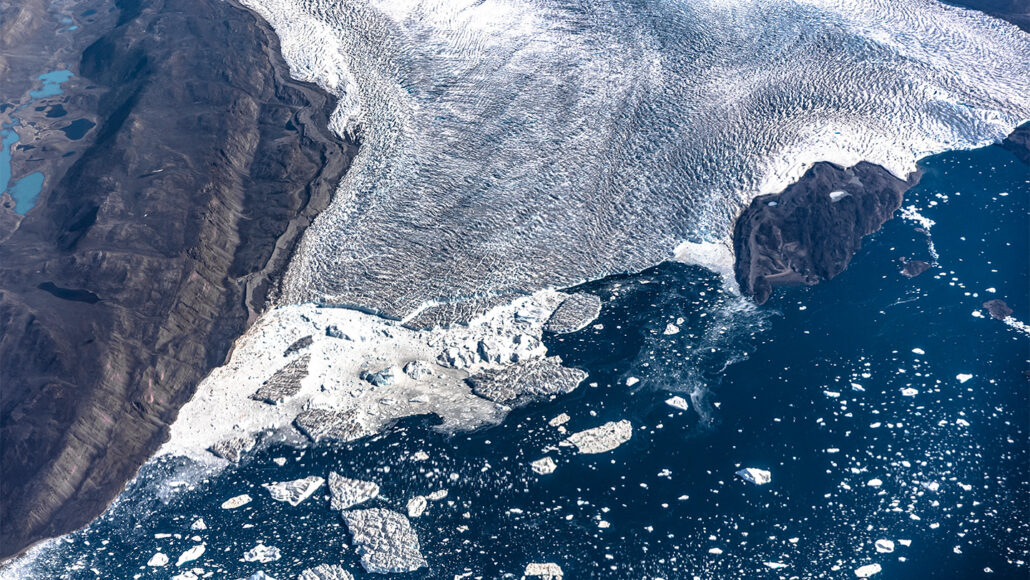Climate change is changing how scientists measure time
Melting ice sheets shift Earth’s mass, slowing its spin; that makes global timekeeping tricky

Earth’s polar ice sheets are melting faster and faster. That includes ice atop Greenland (shown here). Less ice and more water is slowing the planet’s spin, which affects global timekeeping.
KEREM YUCEL/AFP via Getty Images
Climate change may be making it harder to know exactly what time it is.
Satellite measurements show that ice sheets atop Greenland and Antarctica are rapidly melting. That melting is shifting more mass toward Earth’s equator. That’s been slowing the planet’s rotation, which is messing with global timekeeping.
Geophysicist Duncan Agnew made this discovery. He works at the Scripps Institution of Oceanography. That’s in La Jolla, Calif. He shared his finding online March 27 in Nature.
Everyone around the globe sets their clocks based on coordinated universal time, or UTC. That standard is maintained by the world’s most precise timepieces: atomic clocks. But UTC regularly needs to be adjusted. Why? The length of a day is not always exactly the same.
Many factors can alter the speed of Earth’s spin. The sun and moon’s gravitational pull for instance. Or changes to the speed at which Earth’s core rotates. Shifts in the distribution of mass at its surface can affect Earth’s spin, too. So can earthquakes. In 2004, a magnitude 9.1 earthquake rattled Indonesia. The quake altered the land in such a way that it caused Earth to rotate a tiny bit faster, says Agnew.
But the impact of that quake is much smaller than that of melting ice sheets. Agnew finds this particularly startling. Humankind “has done something that affects, measurably, the rotation rate of the entire Earth,” he says.
That could have key consequences for a timekeeping tool called the leap second.

Educators and Parents, Sign Up for The Cheat Sheet
Weekly updates to help you use Science News Explores in the learning environment
Thank you for signing up!
There was a problem signing you up.
A leap-second decision
Scientists invented the leap second to cope with the fact that UTC sometimes needs tweaking to match Earth’s changing rotation. In 1972, international timekeepers agreed to add this extra tick to UTC whenever it was needed. Since then, timekeepers have added 27 leap seconds to the clock.
Still, metrologists — measurement scientists — aren’t too fond of this system. For one thing, leap seconds don’t happen on a set schedule. Plus, systems that rely on precise timekeeping — such as financial markets and satellite navigation systems — each have their own rules and methods for adding a leap second. Those mismatches can actually make it more challenging to have a universal time.
In 2022, an international group of metrologists voted to do away with leap seconds. They favored less frequently adding larger chunks of time to UTC, perhaps a minute. The group resolved to settle those details at its next meeting in 2026.
Do you have a science question? We can help!
Submit your question here, and we might answer it an upcoming issue of Science News Explores
And that might be fortunate. The reason: Changes in the rotation of Earth’s core over the last 20 years have been speeding up the spin of Earth’s surface. Based on that, scientists predicted that Earth would be spinning fast enough by 2026 that they’d no longer need to add leap seconds to UTC. Instead, they’d need to start removing seconds. So, deciding what to do with the leap second in 2026 might be ideal.
Agnew’s research now reveals that climate change has been slowing Earth’s spin. That means timekeepers may not actually need to start removing seconds from our clocks until 2029. So it looks like timekeepers have a bit more time to make their leap-second decision.
But timekeeping adjustments will have to happen by the end of this decade, notes Jerry Mitrovica. He’s a geophysicist at Harvard University. That’s in Cambridge, Mass. One way or another, the world is going to have to start losing time — or international timekeeping strategies will need to change.







